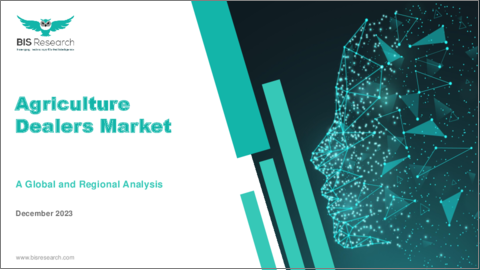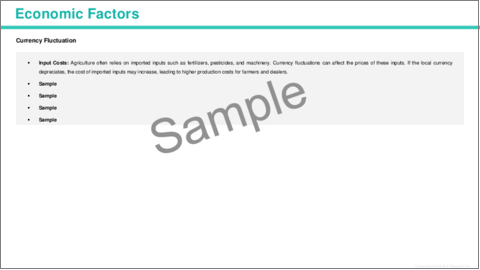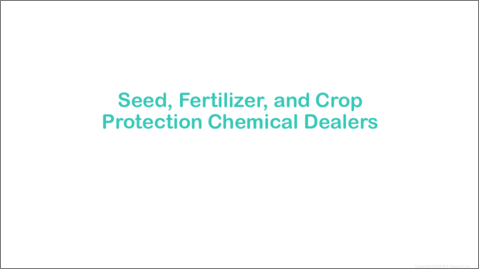|
|
市場調査レポート
商品コード
1429208
農業ディーラー市場- 世界および地域分析Agriculture Dealers Market - A Global and Regional Analysis |
||||||
|
● お客様のご希望に応じて、既存データの加工や未掲載情報(例:国別セグメント)の追加などの対応が可能です。 詳細はお問い合わせください。 |
|||||||
| 農業ディーラー市場- 世界および地域分析 |
|
出版日: 2024年02月21日
発行: BIS Research
ページ情報: 英文 78 Pages
納期: 1~5営業日
|
- 全表示
- 概要
- 目次
農業ディーラー市場は、農産物やサービスの生産、流通、消費にまたがる経済システムである、より広範な農業景観に不可欠な市場です。
そのルーツは1万年以上前に遡り、農業は物々交換の基礎を築いた基礎産業です。時を経て、基本的な道具から遺伝子工学やロボット工学のような近代的な技術への進歩は、農業の効率を一変させました。
農業ディーラーは、農業において極めて重要な役割を果たしています。彼らは生産者からの生産物の購入を促進し、流通と販売を管理します。しかし、このレベルでは、市場慣行や農業ディーラーと投入資材供給業者間の信頼問題などの課題が根強く残っています。
農業ディーラー市場は、世界経済において重要な役割を果たす、複雑で発展途上の分野です。農業ディーラーは、農業エコシステムにおいて極めて重要な役割を担っており、メーカーとエンドユーザーの間の重要な仲介者としての役割を果たしています。その重要性は、農業経営の効率性、生産性、持続可能性に寄与する様々な要因に起因します。
サプライチェーン・マネジメントの最適化:サプライチェーン・マネジメントを最適化する機会を探ることで、ディーラーは資源の枯渇に対処し、潜在的な混乱に対処し、より弾力的で効率的な製品の流れを確保することができます。顧客サービスの向上を優先することは、タイムリーで正確な情報を提供し、信頼できるアフターサービスを確保し、顧客との信頼関係を構築するために製品品質へのコミットメントを維持することにつながります。メーカー、政府機関、非政府組織などの利害関係者との戦略的協力関係を模索することで、集団で課題に対処し、業界共通の目標を追求する機会が得られる可能性があります。
当レポートでは、世界の農業ディーラー市場について調査し、市場の概要とともに、セグメント別の動向と将来の見通しなどを提供しています。
目次
第1章 市場への影響分析
- 経済的要因
- 政策と規制の影響
- 環境要因
- 気候変動と農業
- 農業ディーラーの役割
第2章 市場セグメンテーション
- 設備ディーラー
- 製品と価格の分析
- リスクとギャップの分析
- 機器ディーラーが採用する戦略
- 今後の見通しと動向
- 国別分析
- 主要OEMディーラーの比較と見通し
- ディーラーのエンドユーザー収益の内訳(雇用規模別、2022年)
- さまざまなOEMディーラーのエンドユーザー収益の内訳、2022年
- インプットディーラー
- 製品と価格の分析
- リスクとギャップの分析
- インプットディーラーが採用する戦略
- 今後の見通しと動向
- 国別分析
- 主要投入企業の比較と見通し
- 主要ディーラー一覧
第3章 提言と今後の見通し
- 市場のさまざまな利害関係者に対する提言
- 設備メーカーへの提言
- 農業資材生産者への提言
- 推奨事項精密農業ソリューションプロバイダー
- 農家への提言
第4章 調査手法
BIS Research Study Highlights Agriculture Dealers Market
Introduction of Dealers Market
The agriculture dealers market is integral to the broader agricultural landscape, an economic system spanning the production, distribution, and consumption of agricultural products and services.
With roots dating back over 10,000 years, agriculture has been a foundational industry that laid the groundwork for bartering. Over time, advancements from basic tools to modern technologies such as genetic engineering and robotics have transformed agricultural efficiency.
Agricultural dealers play a pivotal role in the agriculture industry. They facilitate the purchase of outputs from producers, managing distribution and sales. However, challenges such as market practices and trust issues between agriculture dealers and input suppliers persist at this level.
The agriculture dealers market is a complex and evolving field that plays a significant role in the global economy. In this study, three types of dealers have been considered:
- Equipment Dealers: These dealers are involved in the sale and distribution of various agricultural machinery and equipment. They play a crucial role in providing farmers with the necessary tools to carry out their operations efficiently.
- Input Dealers (Seed, Fertilizer, and Crop Protection Chemical): These dealers, often referred to as agriculture dealers, are involved in the supply and distribution of essential agricultural inputs such as seeds, fertilizers, and agrochemicals. They play a vital role in ensuring that farmers have access to quality inputs that can enhance crop yield and productivity.
- Precision Agriculture Dealers: These dealers are involved in the sale and distribution of precision agriculture technologies. Precision agriculture involves the use of advanced technologies to enhance the efficiency and productivity of agricultural operations.
Market Introduction
Agriculture dealers play a pivotal role in the agricultural ecosystem, serving as crucial intermediaries between manufacturers and end users. Their importance stems from various factors that contribute to the efficiency, productivity, and sustainability of farming operations.
Recommendations for Agriculture Dealers
- Considering Embracing Technology: Dealers might find value in exploring the adoption of precision agriculture technologies for equipment, advanced seed and fertilizer technologies for inputs, and digital platforms to enhance their sales and customer service.
- Exploring Supply Chain Management Optimization: Exploring opportunities to optimize supply chain management could help dealers address resource depletion and navigate potential disruptions, ensuring a more resilient and efficient flow of products.
- Prioritizing Enhanced Customer Service: Prioritizing enhanced customer service could involve providing timely and accurate information, ensuring reliable after-sales support, and maintaining a commitment to product quality to build trust with customers.
- Exploring Strategic Collaborations: Exploring strategic collaborations with stakeholders such as manufacturers, government agencies, and non-governmental organizations may present opportunities to collectively address challenges and pursue shared industry goals.
- Educating and Training Staff: Dealers need to ensure that staff members are well-trained and updated on the latest agricultural technologies and practices. This can improve customer service and support, helping farmers make informed decisions.
- Providing Financing Options: Dealers could offer flexible financing options to farmers, addressing their credit needs. Establishing partnerships with financial institutions or implementing in-house financing programs can enhance customer accessibility.
How can this report add value to an organization?
Primary Research
The primary sources involve agriculture industry experts and stakeholders such as dealers and service providers. Respondents such as vice presidents, CEOs, marketing directors, and technology and innovation directors have been interviewed to verify this research study's qualitative and quantitative aspects.
The key data points taken from primary sources include:
- Need/importance of agriculture dealers
- Challenges for agriculture dealers and manufacturers
- Role of agriculture dealers in the industry
Secondary Research
The research study 'Agriculture Dealers Market' involves the usage of extensive secondary research, directories, company websites, and annual reports. It also makes use of databases, such as Hoovers, Bloomberg, Businessweek, and Factiva, to collect useful and effective information for an extensive, technical, market-oriented, and commercial study of the global market. In addition to the aforementioned data sources, the study has been undertaken with the help of other data sources and websites, such as www.fao.org and www.worldbank.org.
Secondary research was done to obtain crucial information about the industry's value chain, revenue models, the market's monetary chain, the total pool of key players, and the current and potential use cases and applications.
Table of Contents
1 Markets Impact Analysis
- 1.1 Economic Factors
- 1.1.1 Currency Fluctuation
- 1.2 Policy and Regulatory Influences
- 1.2.1 Trade Policies
- 1.2.2 Government Support
- 1.3 Environmental Factors
- 1.3.1 Climate Change and Agriculture
- 1.3.2 Role of Agriculture Dealers
2 Market Segmentation
- 2.1 Equipment Dealers
- 2.1.1 Product and Pricing Analysis
- 2.1.2 Risk and Gap Analysis
- 2.1.3 Strategies Adopted by Equipment Dealers
- 2.1.4 Future Outlook and Trends
- 2.1.5 Country Analysis
- 2.1.5.1 U.S. Agriculture Dealers Market
- 2.1.5.2 China Agriculture Dealers Market
- 2.1.5.3 India Agriculture Dealers Market
- 2.1.5.4 Germany Agriculture Dealers Market
- 2.1.5.5 Brazil Agriculture Dealers Market
- 2.1.6 Comparison and Outlook of Key OEM Dealers
- 2.1.7 End-user Revenue Break-up of Dealers by Employment Size, 2022
- 2.1.8 End-user Revenue Break-up of Different OEM Dealers, 2022
- 2.1.8.1 List of Key Dealers
- 2.1.8.2 Dealers of Major OEM Companies
- 2.2 Input Dealers
- 2.2.1 Product and Pricing Analysis
- 2.2.2 Risk and Gap Analysis
- 2.2.3 Strategies Adopted by Input Dealers
- 2.2.4 Future Outlook and Trends
- 2.2.5 Country Analysis
- 2.2.5.1 U.S. Agriculture Dealers Market
- 2.2.5.2 China Agriculture Dealers Market
- 2.2.5.3 India Agriculture Dealers Market
- 2.2.5.4 Germany Agriculture Dealers Market
- 2.2.5.5 Brazil Agriculture Dealers Market
- 2.2.6 Comparison and Outlook of Key Input Companies
- 2.2.7 List of Key Dealers
3 Recommendations and Future Outlook
- 3.1 Recommendations for Different Stakeholders in the Market
- 3.1.1 Recommendations for Equipment Manufacturers
- 3.1.2 Recommendations for Agriculture Input Producers
- 3.1.3 Recommendations Precision Agriculture Solution Providers
- 3.1.4 Recommendations for Farmers




